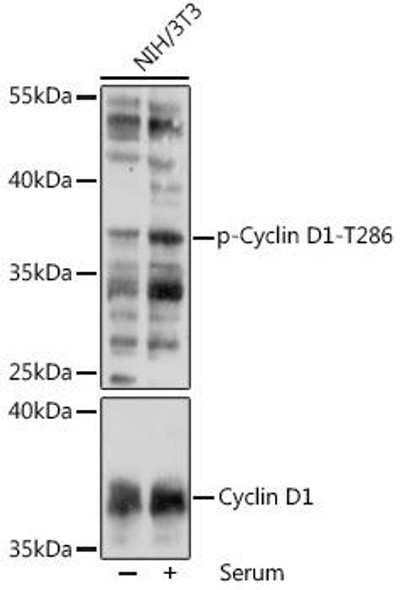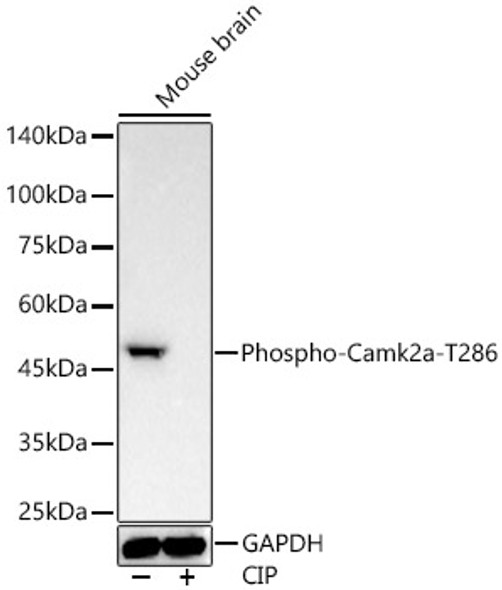Cell Biology Antibodies 16
Anti-Phospho-Camk2a-T286 Antibody (CABP0255)
- SKU:
- CABP0255
- Product Type:
- Antibody
- Applications:
- WB
- Reactivity:
- Human
- Reactivity:
- Mouse
- Reactivity:
- Rat
- Host Species:
- Rabbit
- Isotype:
- IgG
- Research Area:
- Cell Biology
Description
| Antibody Name: | Anti-Phospho-Camk2a-T286 Antibody |
| Antibody SKU: | CABP0255 |
| Antibody Size: | 20uL, 50uL, 100uL |
| Application: | WB |
| Reactivity: | Human, Mouse, Rat |
| Host Species: | Rabbit |
| Immunogen: | A phospho specific peptide corresponding to residues surrounding T286 of human Camk2a |
| Application: | WB |
| Recommended Dilution: | WB 1:500 - 1:2000 |
| Reactivity: | Human, Mouse, Rat |
| Positive Samples: | Mouse brain |
| Immunogen: | A phospho specific peptide corresponding to residues surrounding T286 of human Camk2a |
| Purification Method: | Affinity purification |
| Storage Buffer: | Store at -20°C. Avoid freeze / thaw cycles. Buffer: PBS with 0.02% sodium azide, 50% glycerol, pH7.3. |
| Isotype: | IgG |
| Sequence: | Email for sequence |
| Gene ID: | 815 |
| Uniprot: | Q9UQM7 |
| Cellular Location: | Cell junction, presynaptic cell membrane, synapse |
| Calculated MW: | 22kDa/54kDa |
| Observed MW: | 54kDa |
| Synonyms: | CAMK2A, CAMKA |
| Background: | The product of this gene belongs to the serine/threonine protein kinases family, and to the Ca(2+)/calmodulin-dependent protein kinases subfamily. Calcium signaling is crucial for several aspects of plasticity at glutamatergic synapses. This calcium calmodulin-dependent protein kinase is composed of four different chains: alpha, beta, gamma, and delta. The alpha chain encoded by this gene is required for hippocampal long-term potentiation (LTP) and spatial learning. In addition to its calcium-calmodulin (CaM)-dependent activity, this protein can undergo autophosphorylation, resulting in CaM-independent activity. Two transcript variants encoding distinct isoforms have been identified for this gene. |
| UniProt Protein Function: | CAMK2A: a protein kinase of the CAMK2 family. A prominent kinase in the central nervous system that may function in long-term potentiation and neurotransmitter release. Member of the NMDAR signaling complex in excitatory synapses that may regulate NMDAR-dependent potentiation of the AMPAR and synaptic plasticity. The holoenzyme is composed of four different chains: alpha, beta, gamma, and delta. The different chains assemble into homo- or heteromultimeric holoenzymes composed of 8 to 12 subunits. May interact with BAALC, MPDZ, SYN1 and synGAP. 2 isoforms of the human protein are produced by alternative splicing. |
| UniProt Protein Details: | Protein type:Protein kinase, CAMK; EC 2.7.11.17; Protein kinase, Ser/Thr (non-receptor); Kinase, protein; CAMK group; CAMK2 family Chromosomal Location of Human Ortholog: 5q32 Cellular Component: cytosol; mitochondrion; nucleoplasm; nucleus; plasma membrane Molecular Function:calmodulin binding; glutamate receptor binding; kinase activity; protein binding; protein homodimerization activity; protein serine/threonine kinase activity; Ras guanyl-nucleotide exchange factor activity Biological Process: activation of NF-kappaB transcription factor; calcium ion transport; G1/S transition of mitotic cell cycle; MAPKKK cascade; peptidyl-serine phosphorylation; positive regulation of calcium ion transport; protein amino acid autophosphorylation; protein amino acid phosphorylation; regulation of neuronal synaptic plasticity; regulation of neurotransmitter secretion; Wnt receptor signaling pathway, calcium modulating pathway |
| NCBI Summary: | The product of this gene belongs to the serine/threonine protein kinases family, and to the Ca(2+)/calmodulin-dependent protein kinases subfamily. Calcium signaling is crucial for several aspects of plasticity at glutamatergic synapses. This calcium calmodulin-dependent protein kinase is composed of four different chains: alpha, beta, gamma, and delta. The alpha chain encoded by this gene is required for hippocampal long-term potentiation (LTP) and spatial learning. In addition to its calcium-calmodulin (CaM)-dependent activity, this protein can undergo autophosphorylation, resulting in CaM-independent activity. Two transcript variants encoding distinct isoforms have been identified for this gene. [provided by RefSeq, Nov 2008] |
| UniProt Code: | Q9UQM7 |
| NCBI GenInfo Identifier: | 296434552 |
| NCBI Gene ID: | 815 |
| NCBI Accession: | Q9UQM7.2 |
| UniProt Secondary Accession: | Q9UQM7,Q9UL21, Q9Y2H4, Q9Y352, |
| UniProt Related Accession: | Q9UQM7 |
| Molecular Weight: | 55,320 Da |
| NCBI Full Name: | Calcium/calmodulin-dependent protein kinase type II subunit alpha |
| NCBI Synonym Full Names: | calcium/calmodulin dependent protein kinase II alpha |
| NCBI Official Symbol: | CAMK2A |
| NCBI Official Synonym Symbols: | CAMKA |
| NCBI Protein Information: | calcium/calmodulin-dependent protein kinase type II subunit alpha |
| UniProt Protein Name: | Calcium/calmodulin-dependent protein kinase type II subunit alpha |
| Protein Family: | Calcium/calmodulin-dependent protein kinase |
| UniProt Gene Name: | CAMK2A |
| UniProt Entry Name: | KCC2A_HUMAN |







